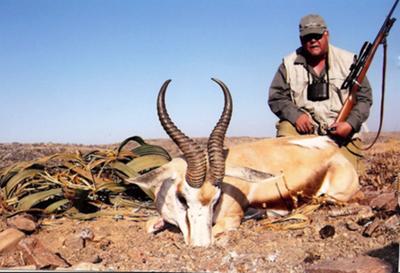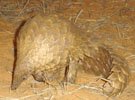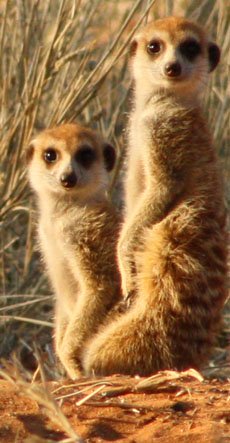Harley-Davidson Horns
by Stephan Hofmann
(Illinois, USA)
The Antelope were territorial. The big males escorted a herd of females and fought for this right. The big males weighed about 125 pounds and sported black backswept "Harley-Davidson" horns. A good male would have 15-16 inch horns.
My guide Adam and I spotted a large male Antelope with one horn longer than the other. Adam said the horn had mass. I put my scope on the Antelope but could not stop the crosshairs from wavering. The Antelope ran away. Adam said that animals can sense evil intent from hunters and try to escape.
We carefully glassed the terraine and spotted a herd about one mile away. We traveled to a hill overlooking the herd. We climbed the hill and saw three large male Antelope among the females. I crawled over the summit of the hill, put down my rifle so that it rested on the bipod pointing down hill. Adam chose a good animal for me. I quickly aimed and took a shot.
The shot missed and the herd started to run. I snapped off another shot and missed again. Adam got quite perturbed with my wild shooting. He made me walk back to the truck alone. I felt bad.
I pulled out some dried meat and gave some to Adam. He said the meat always brings luck.
We glassed another large herd in a wide expanse of green grass which I called the Serengeti.
It was a verdant and beautiful setting. We prepared another ambush. We crawled up a hill overlooking the herd. We had to crawl through thorns and prickly brush. We reached the summit. Down below in the Serengeti were three Antelope males; two large ones at 300 yards, and one smaller one at 200 yards. I did not want to miss again so I decided to try for the Antelope at 200 yards.
I carefully placed the crosshairs behind the left shoulder and slowly squeezed the trigger. The Antelope dropped at the shot in it’s tracks. We climbed down the hill and went up to the Antelope. The bullet had entered behind the left shoulder and exited out the right kidney. Adam measured the horns and they were 14 inches. He smiled and congratulated me.
I was happy with my first antelope.
This all happened in Wyoming, USA, in 2004!!
In 2007 I decided to journey to Namibia, Africa, for a shooting Safari. After five days I had been very successful and had used my Ruger .300 Win Mag to harvest Red Hartebeest, Zebra, Gemsbok, Warthog and Kudu. I needed to harvest a Kalahari Springbok.
The Kalahari Springbok occurs in great abundance in the Eastern sand desert of the Kalahari and the dry Western desert of the Namib. The animal attains great horn size in Namibia. Some call the Springbok from the Namib Desert the "Holy Grail" or "Methusalem" of Springbok because of their large back swept "Harley-Davidson" horns.
The Springbok is similar to the North American Pronghorn Antelope and occupies a similar ecological niche. I had a lot of experience hunting Pronghorn in Wyoming and was looking forward to my hunt in the Namib Desert to hunt Springbok.
My PH Barry, my tracker and driver Yassir, and I entered the Namib Desert at the town of Khorixas. We gassed up and bought water. We ventured into the Namib Desert; the country became increasingly desolate as we pointed the truck on a track north of the Brandeberg Escarpment.
The Mopane trees were becoming scarce and the land appeared to be dry and lifeless. However, there were many herds of Springbok about. Every ram had his territory and a herd of females. Barry said that at certain times of the year the herds of Springbok would gather by the Brandeberg and they would number in the thousands.
We came to a flat plain. Barry spotted a nice Springbok Ram. I took careful aim but missed. Barry said that this was a trophy of a lifetime. We followed the ram and I got another shot. This time I aimed carefully with my rifle supported by the bipod and sent a 180 g Cor Lokt bullet into the ram, dropping it in its tracks. The ram extended it’s pronk after it died. The pronk is a pocket of long white hair that opens on the animals dorsal area when it is excited or in it’s death throes, hence it’s scientific name Antidorcas marsupialis. The pronk smells like sweet cotton candy when one sticks his nose in it.
My Springbok sported 15.5 inch horns... a true trophy. Gold Medal Class in Namibia.
We stopped at midday and rested under a large Mopane tree. Yassir skinned the Springbok and salted the cape and hide. We made a fire and grilled Springbok steak, kidneys, and ribs.
What a feast!!
After a nice rest under the Mopane tree we traveled deeper into the Desert in search of another Springbok. We came to a series of dry plateaus. There were many Welwitchia plants on the dry plateaus. These are fossil plants that only grow in the Namib Desert of Angola and Namibia.
These plants have adapted beautifully to the harsh and dry climate of the Desert by developing a large underground trunk that enables the plant to search for water at great depths.
We came across a herd of Springbok led by an extremely large bodied ram. I wanted to take a shot. Barry could not tell how large the horns were because the body of the animal for comparison was so large. I carefully aimed and squeezed off a shot at about 150 yards. The Springbok dropped next to a Welwitchia plant. We took some great photos. This ram was 16 inches, a true "Methusalem" from the Namib Desert!!
From this experience I concluded that Springbok hunting in the Deserts of Namibia was every bit as fun as Pronghorn hunting on the Plains of Wyoming.
Stephan Hofmann
Comments for Harley-Davidson Horns
|
||
|
||
|
||
|
||
|
||
|
||
|
||
|
||
|
||

Meaning of "Uitspan"
'Uitspan' is an Afrikaans word that means place of rest.
When the Boer settlers moved inland in Southern Africa in the 1800's, they used ox carts. When they found a spot with game, water and green grass, they arranged their ox carts into a circular laager for protection against wild animals and stopped for a rest.
They referred to such an action of relaxation for man and beast, as Uitspan.
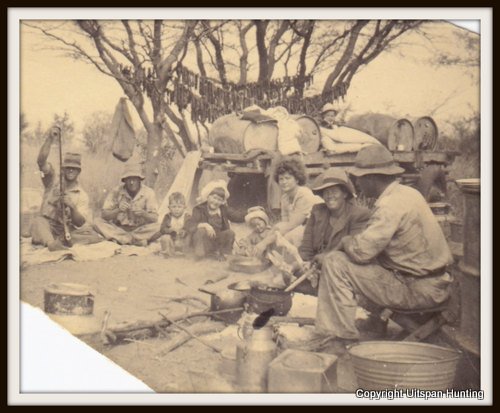
(Picture above of our ancestors.)
Did you know?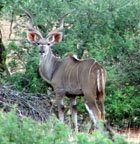 Greater Southern Kudus are famous for their ability to jump high fences. A 2 m (6.56 ft) fence is easily jumped while a 3 m (9.84 ft) high fence is jumped spontaneously. These strong jumpers are known to jump up to 3.5 m (11.48 ft) under stress. |
to read about my experience...
Did you know? Some animals have one sense more than man!The flehmen response is a particular type of curling of the upper lip in ungulates, felids and many other mammals. This action facilitates the transfer of pheromones and other scents into the vomeronasal organ, also called the Jacobson's Organ. Some animals have one sense more than man!The flehmen response is a particular type of curling of the upper lip in ungulates, felids and many other mammals. This action facilitates the transfer of pheromones and other scents into the vomeronasal organ, also called the Jacobson's Organ.This behavior allows animals to detect scents (for example from urine) of other members of their species or clues to the presence of prey. Flehming allows the animals to determine several factors, including the presence or absence of estrus, the physiological state of the animal, and how long ago the animal passed by. This particular response is recognizable in males when smelling the urine of a females in heat. |
